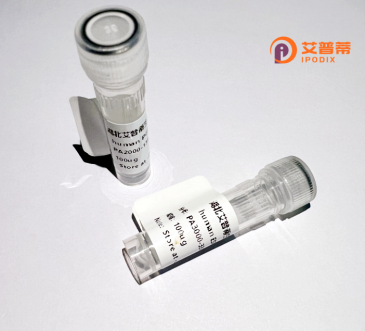
| 纯度 | >90%SDS-PAGE. |
| 种属 | Human |
| 靶点 | SMARCAD1 |
| Uniprot No | Q9H4L7 |
| 内毒素 | < 0.01EU/μg |
| 表达宿主 | E.coli |
| 表达区间 | 1-1028 aa |
| 活性数据 | MNLFNLDRFRFEKRNKIEEAPEATPQPSQPGPSSPISLSAEEENAEGEVSRANTPDSDITEKTEDSSVPETPDNERKASISYFKNQRGIQYIDLSSDSEDVVSPNCSNTVQEKTFNKDTVIIVSEPSEDEESQGLPTMARRNDDISELEDLSELEDLKDAKLQTLKELFPQRSDNDLLKLIESTSTMDGAIAAALLMFGDAGGGPRKRKLSSSSEPYEEDEFNDDQSIKKTRLDHGEESNESAESSNNWEKQESIVLKLQKEFPNFDKQELREVLKEHEWMYTEALESLKVFAEDQDMQYASQSEVPNGKEVSSRSQNYPKNATKTKLKQKFSMKAQNGFNKKRKKNVFNQKRVVEDSEYDSGSDVGSSLDEDYSSGEEVMEDGYKGKILHFLQDASIGELTLIPQCSQKKAQKITELRPFNSWEALFTKMSKTNGLSEDLIWHCKTLIQERDVVIRLMNKCEDISNKLTKQVTMLTGNGGGWNIEQPSILNQSLSLKPYQKVGLNWLALVHKHGLNGILADEMGLGKTIQAIAFLAYLYQEGNNGPHLIVVPASTIDNWLREVNLWCPTLKVLCYYGSQEERKQIRFNIHSRYEDYNVIVTTYNCAISSSDDRSLFRRLKLNYAIFDEGHMLKNMGSIRYQHLMTINANNRLLLTGTPVQNNLLELMSLLNFVMPHMFSSSTSEIRRMFSSKTKSADEQSIYEKERIAHAKQIIKPFILRRVKEEVLKQLPPKKDRIELCAMSEKQEQLYLGLFNRLKKSINNLVTEKNTEMCNVMMQLRKMANHPLLHRQYYTAEKLKEMSQLMLKEPTHCEANPDLIFEDMEVMTDFELHVLCKQYRHINNFQLDMDLILDSGKFRVLGCILSELKQKGDRVVLFSQFTMMLDILEVLLKHHQHRYLRLDGKTQISERIHLIDEFNTDMDIFVFLLSTKAGGLGINLTSANVVILHDIDCNPYNDKQAEDRCHRVGQTKEALVIKLISQGTIEESMLKINQQKLKLEQDMTTVDEGDEGSMPADIATLLKTSMGL |
| 分子量 | 144 kDa |
| 蛋白标签 | GST-tag at N-terminal |
| 缓冲液 | PBS, pH7.4, containing 0.01% SKL, 1mM DTT, 5% Trehalose and Proclin300. |
| 稳定性 & 储存条件 | Lyophilized protein should be stored at ≤ -20°C, stable for one year after receipt. Reconstituted protein solution can be stored at 2-8°C for 2-7 days. Aliquots of reconstituted samples are stable at ≤ -20°C for 3 months. |
| 复溶 | Always centrifuge tubes before opening.Do not mix by vortex or pipetting. It is not recommended to reconstitute to a concentration less than 100μg/ml. Dissolve the lyophilized protein in distilled water. Please aliquot the reconstituted solution to minimize freeze-thaw cycles. |
以下是关于重组人SMARCAD1蛋白的3篇参考文献及其摘要概括:
1. **文献名称**:*SMARCAD1 is a chromatin remodeler promoting transcriptional heterogeneity and pluripotency*
**作者**:Costello, I., et al.
**摘要**:研究揭示了SMARCAD1通过染色质重塑维持胚胎干细胞的异质性和多能性,重组蛋白实验表明其ATP酶活性对开放染色质区域调控至关重要。
2. **文献名称**:*Recombinant SMARCAD1 interacts with the replication machinery and regulates DNA replication*
**作者**:Rowbotham, S.P., et al.
**摘要**:利用重组SMARCAD1蛋白证明其与DNA复制复合物直接结合,通过影响复制叉进程调控基因组稳定性,提示其在癌症中的作用机制。
3. **文献名称**:*Structural basis of SMARCAD1 ATPase activity in chromatin remodeling*
**作者**:Hiratani, I., et al.
**摘要**:通过重组蛋白的体外实验解析了SMARCAD1的ATP酶结构域构象变化,阐明其对染色质结构动态调控的分子机制。
这些研究均基于重组SMARCAD1蛋白的实验,聚焦其染色质重塑、DNA复制调控及结构功能分析。
The SMARCAD1 protein, a member of the SWI/SNF chromatin-remodeling family, plays a critical role in regulating genome stability and epigenetic landscapes. Functioning as an ATP-dependent chromatin remodeler, it unwinds or reposition nucleosomes to modulate DNA accessibility for processes like replication, repair, and transcription. Unlike many SWI/SNF proteins, SMARCAD1 lacks a bromodomain but contains conserved RecA-like ATPase domains and interacts with PCNA, highlighting its involvement in DNA replication and damage response. Studies link SMARCAD1 to both heterochromatin maintenance (via interactions with HP1 proteins) and active DNA demethylation pathways, revealing context-dependent roles in gene silencing or activation.
Recombinant human SMARCAD1 proteins, typically expressed in E. coli or mammalian systems, enable structural and functional studies. These purified tools help dissect its chromatin-remodeling mechanisms, including ATP hydrolysis-driven nucleosome sliding. Aberrant SMARCAD1 expression is associated with cancer progression, premature aging disorders, and replication stress-related pathologies, making it a potential therapeutic target. Ongoing research focuses on its dual functionality in epigenetic regulation and genome surveillance, with recombinant variants facilitating drug screening and mechanistic exploration. Its unique ability to act on single-stranded DNA further implicates SMARCAD1 in replication fork restart and telomere homeostasis.
×